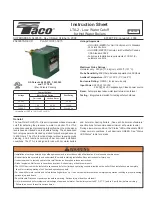
Tx I&O Manual
│
General Venting
11
Direct Vent Installation (Best Practice)
When installed as a Direct Vent boiler the combustion air-inlet must also be piped directly to the outdoors using
the methods described in this section and in accordance with the National Fuel Gas Code, ANSI Z223.1 (U.S.) or
CSA B149.1 (Canada) and local requirements.
Installation Using Indoor Combustion Air
When the installation uses Indoor Combustion Air (i.e. piping is not directly connecting the appliance air-inlet
fitting to the outdoors), provisions for combustion and ventilation air, in accordance with section “Air for
Combustion and Ventilation,” of the
National Fuel Gas Code, ANSI Z223.1/NFPA 54
(U.S.), or Clause 8.2, 8.3
or 8.4 of
Natural Gas and Propane Installation Code, CAN/CSA B149.1
(Canada), or applicable provisions of
the local building codes, must be adhered to.
The boiler shall be located so as not to interfere with proper circulation of combustion,
ventilation, and dilution air.
Make up air requirements for the operation of exhaust fans, kitchen ventilation systems,
clothes dryers, and fireplaces shall be considered in determining the adequacy of a space
to provide combustion air requirements. Failure to ensure adequate make up air to all
appliances may result in personal injury or death.
Combustion Air-inlet Contamination
Be careful not to locate the air-inlet termination in an area where contaminants can be drawn in and used for
combustion. Combustion air containing dust, debris or air-borne contaminants will drastically increase the
required maintenance and may cause a corrosive reaction in the Heat Exchanger which could result in premature
failure, fire, serious injury, or death.
See Table 4-1 for a list of areas to avoid when terminating air-inlet piping:
Table 4-1 Corrosive Products and Contaminant Sources
Products to Avoid
Contaminated Sources to Avoid
Antistatic fabric softeners, bleaches, detergents, cleaners
Laundry facilities
Perchloroethylene (PCE), hydrocarbon based cleaners
Dry cleaning facilities
Chemical fertilizer, herbicides/pesticides, dust, methane gas
Farms or areas with livestock and manure
Paint or varnish removers, cements or glues, sawdust
Wood working or furniture refinishing shops
Water chlorination chemicals (chloride, fluoride)
Swimming pools, hot tubs
Solvents, cutting oils, fiberglass, cleaning solvents
Auto body or metal working shops
Refrigerant charge with CFC or HCFC
Refrigerant repair shops
Permanent wave solutions
Beauty shops
Fixer, hydrochloric acid (muriatic acid), bromide, iodine
Photo labs, chemical / plastics processing plants
Cement powder, crack fill dust, cellulose, fiber based insulation
Concrete plant or construction site
Do not store or use gasoline or other flammable vapors and liquids in the vicinity of this
or any other boiler. Failure to follow instructions may result in serious injury or death.
It is
BEST PRACTICE
to pipe the combustion air-inlet directly to the outdoors (Direct
Vent installation) to avoid contamination often contained in indoor air.
Flammable Solvents and Plastic Piping
Due to the extremely flammable characteristics of most glues, cements, solvents and primers used in the process
of joining plastic vent and air-inlet pipe, explosive solvent vapors must be evacuated from the vent and air-inlet
prior to start-up. Avoid using excess cement or primer that may lead to pooling inside the pipe assembly. Freshly
assembled piping assembly should be allowed to cure for a minimum of 8 hours before applying power to the gas
fired boiler. Refer to
Mandatory Pre-commissioning Procedure for Plastic Venting
in this section.
Flammable Cements and Primers
– It is the installers’ responsibility to familiarize
themselves with the hazards associated with explosive solvents and to take all precautions
to reduce these risks. Failure to follow these instructions can cause explosions, property
damage, injury or death.












































